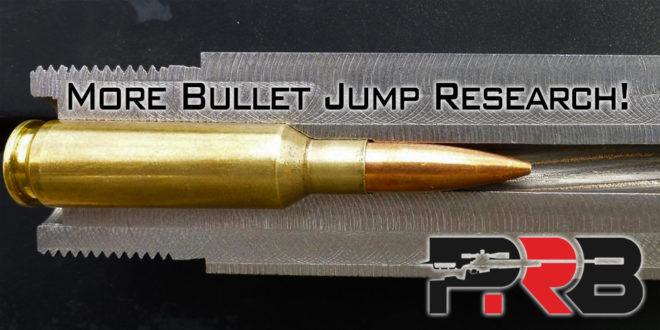Actually you can find a forgiving load away from the lands.

 precisionrifleblog.com
precisionrifleblog.com

More Bullet Jump Research!
This is the 4th article in a series on some new research on bullet jumps. Here is a recap of the pr...
 Help Support Long Range Hunting Forum
Help Support Long Range Hunting Forum

This is what I'm trying to relay to folks.One more anecdote - when testing a barrel tuner, you WANT bad groups so you can really see how the tuner moves them. So you have to find a bad load to test the one particular thing you're changing. If you shoot one hole at 100, there's no real way other than going really far away to see the changes. If you shoot 3" at 100 yards you can see the tuner swing the group around. You want to see the effects of seating depth, so pick a charge weight that makes bad groups so you can see the group size move with seating depth. When you bring the depth and charge node together, you should have a resilient, long lasting load going forward that doesn't need to be tweaked for a while.
This is true for some bullets as was mentioned. The ELD-M however does not have the Tangent Ogive of the Berger bullets. Bullets with the Secant Ogive are much more sensitive to seating depth than those with a secant Ogive.Actually you can find a forgiving load away from the lands.

More Bullet Jump Research!
This is the 4th article in a series on some new research on bullet jumps. Here is a recap of the pr...precisionrifleblog.com
I'm still at odds with finding powder charge at .020 off lands, if I find node at .060 off lands my pressure has increased, will this now effect my es, I'm thinking it will and if it does I may have to change charge and if that happens what's the point of finding charge at .020 off lands.I agree with you, concentricity does make better groups. What I'm getting at is along the lines of one of Mike's points, if you want to test something get out of the node. So while a honed die is the best option long run, in the short run experimenting with the bushings and mandrels in a not-good place for concentricity is fine because you know you can tune out the effects induced by it because you've done it.
Let me try another way - accept worse groups while you're messing with the neck setting and deciding which spec to get a honed die for. The groups will get better when you start using the correctly spec'd die and runout gets better again. Or you might already have the spec, if you're happy with the bushing mandrel you have, order the die for that spec. But you just introduced annealing, so it might take a few loads to get to a consistent spec again.
One more anecdote - when testing a barrel tuner, you WANT bad groups so you can really see how the tuner moves them. So you have to find a bad load to test the one particular thing you're changing. If you shoot one hole at 100, there's no real way other than going really far away to see the changes. If you shoot 3" at 100 yards you can see the tuner swing the group around. You want to see the effects of seating depth, so pick a charge weight that makes bad groups so you can see the group size move with seating depth. When you bring the depth and charge node together, you should have a resilient, long lasting load going forward that doesn't need to be tweaked for a while.
You can try doing a seating depth test at the lowest charge for your cartridge, once you find the sweet spot for the seating depth, then worry about the powder charge.I'm still at odds with finding powder charge at .020 off lands, if I find node at .060 off lands my pressure has increased, will this now effect my es, I'm thinking it will and if it does I may have to change charge and if that happens what's the point of finding charge at .020 off lands.
The whole point was to find the charge first according to Eric Cortina and then find seating depth, I do kinda the opposite like you suggest, find depth and then charge but some say, including Cortina, that you are chasing your tail.You can try doing a seating depth test at the lowest charge for your cartridge, once you find the sweet spot for the seating depth, then worry about the powder charge.
I just do what works for me, Berger also recommended seating depth test first at lowest charge then work on powder charge.The whole point was to find the charge first according to Eric Cortina and then find seating depth, I do kinda the opposite like you suggest, find depth and then charge but some say, including Cortina, that you are chasing your tail.
Is this in your Savage AR? Because there are two discussions here, the theory of how changing seating depth impacts pressure and timing, and the practical of what's actually happening with your current load.I'm still at odds with finding powder charge at .020 off lands, if I find node at .060 off lands my pressure has increased, will this now effect my es, I'm thinking it will and if it does I may have to change charge and if that happens what's the point of finding charge at .020 off lands.
The powder charge will most likely stay the same as seating depth changes. At least in the bottle necked cases used in LR stuff. Don't try that in a pistol.I guess no one really has an answer on will powder charge remain the same so guess the best answer is to try it out but I don't see powder charge staying the same if length gets shortened quite a bit, book calls for 2.225, .020 of lands is 2.290, it's shooting great at 2.225 but never tried it over 2.250 cause it sucked at that but maybe it will be outstanding somewhere between that and 2.290, I think Ill be chasing my tail, lol.
Actually it is for my bolt gun which I'm shooting 55gr VMAX, crimp ring sits out pretty far at 2.290, I'll probably start .030 out from landsIs this in your Savage AR? Because there are two discussions here, the theory of how changing seating depth impacts pressure and timing, and the practical of what's actually happening with your current load.
In theory yes, moving a seating depth 0.040" could be enough to make an impact on pressure and muzzle velocity stats of ES/SD. Minor tweaking of 0.010" one way or the other might not push you out of a node.
Sounds like you already ran some loads seated progressively slightly longer from the book COL and groups opened up. This is a small case but also a small bullet, seating depth changes case volume more on large bullets/small cases. So in the specific case of your AR I'm not sure you could move the heavy bullets (70gn+ right?) you're shooting out long enough to feed to get to 0.020" off, so are you trying to do this just to find out? Or would you be ok single feeding to run the load?
The whole point was to find the charge first according to Eric Cortina and then find seating depth, I do kinda the opposite like you suggest, find depth and then charge but some say, including Cortina, that you are chasing your tail.